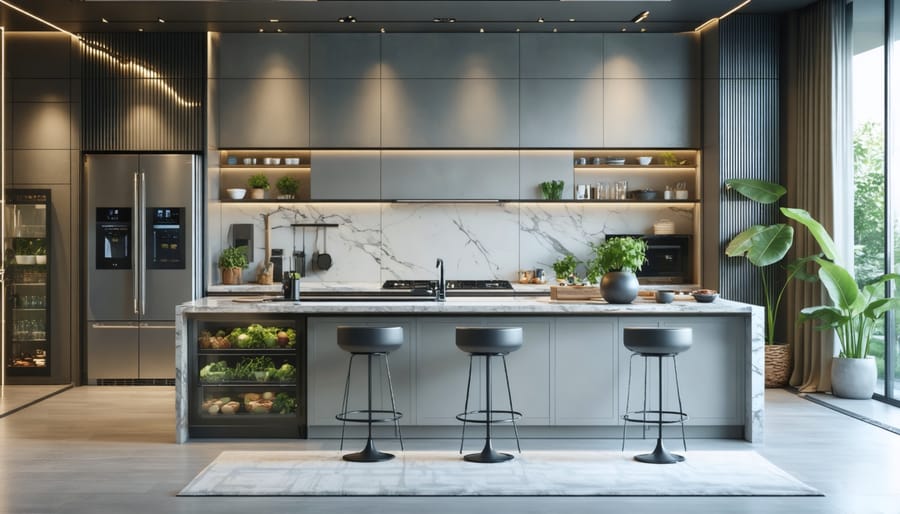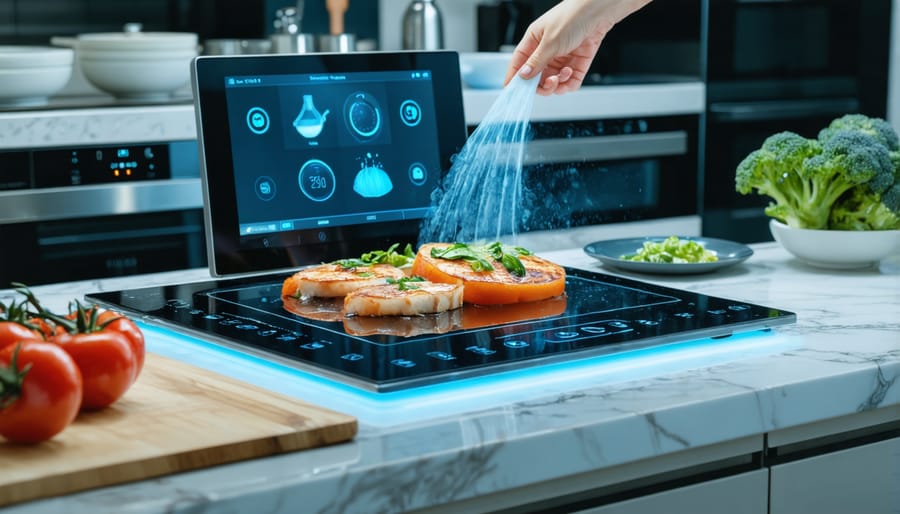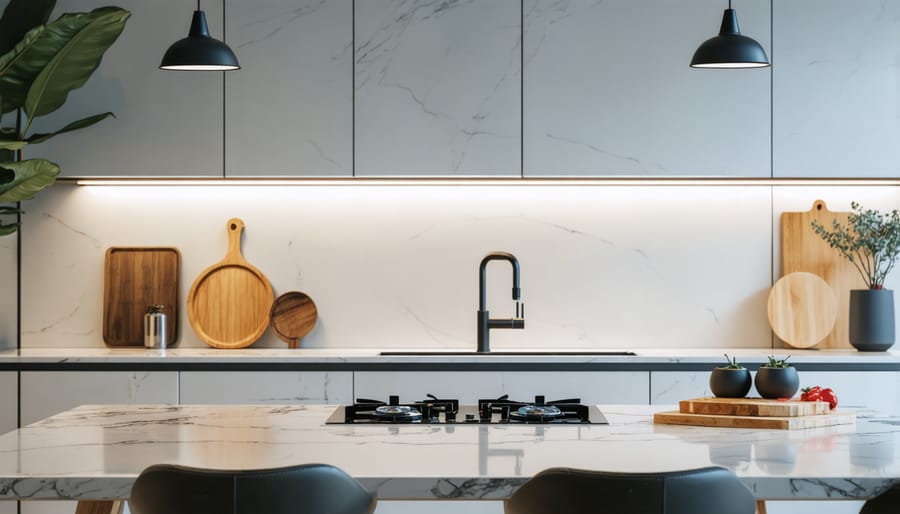Transform your kitchen into a modern culinary command center by integrating smart kitchen features with intelligent design principles. Position your appliances in a triangular workflow between the sink, refrigerator, and cooking area to minimize unnecessary movement. Install under-cabinet lighting with motion sensors to illuminate work surfaces precisely when needed, while voice-activated faucets and touchless waste bins reduce contact points and enhance hygiene. Create designated zones for food prep, cooking, and cleaning, each equipped with smart storage solutions like pull-out pantry systems and charging drawers for devices. Layer your lighting with a mix of task, ambient, and accent fixtures controlled through a single smart hub, allowing you to adjust the atmosphere instantly for cooking, entertaining, or casual dining. These innovative design choices not only elevate your kitchen’s functionality but also future-proof your space for years to come.
Space-Saving Smart Solutions
Integrated Appliance Zones
Creating efficient work zones with integrated smart appliances is key to a well-functioning kitchen. Think of your kitchen as a collection of purpose-driven zones: cooking, prep, cleaning, and storage. Start by positioning your smart refrigerator near the entrance of your kitchen, making it easily accessible for both cooking and unloading groceries. Place your smart oven and cooktop in a dedicated cooking zone, ideally with counter space on both sides for safe and convenient food handling.
Create a prep zone with smart countertop appliances like connected food processors and smart scales, keeping them within arm’s reach of your main work surface. Install your smart dishwasher near the sink to establish an efficient cleaning zone, and consider adding a smart trash bin nearby for seamless waste management.
For maximum efficiency, arrange your small appliances based on frequency of use. Daily-use items like smart coffee makers should be easily accessible, while occasional-use appliances can be stored in cabinets with smart organization systems. Remember to include adequate power outlets with USB ports throughout these zones, and consider installing under-cabinet lighting that can be controlled through your smart home system. This zoned approach not only maximizes your kitchen’s functionality but also helps reduce unnecessary movement while cooking and cleaning.

Hidden Tech Storage Solutions
In today’s connected kitchen, keeping devices charged and organized doesn’t mean sacrificing style for function. One of the most popular solutions is the hidden charging drawer – a dedicated space beneath your countertop equipped with power outlets and USB ports. This clever addition keeps tablets, phones, and other devices tucked away while charging, maintaining a clutter-free workspace.
Consider installing a pop-up power station directly into your kitchen island or countertop. These sleek units remain hidden when not in use and rise with a simple touch when needed. For a budget-friendly alternative, transform an existing drawer into a charging station by adding a power strip and cable management system.
Don’t forget about dedicated spots for your smart kitchen devices. Install a pull-out shelf at counter height to house your smart speaker or digital recipe display. Custom cabinet solutions can include built-in docking stations for tablets, keeping them at eye level while cooking but easily concealed when not in use.
Create a “tech zone” by incorporating a small cabinet with interior outlets and adjustable shelving. This space can store and charge everything from wireless kitchen thermometers to bluetooth-enabled coffee makers. Use drawer dividers and cable clips to keep cords organized and prevent tangling.
Remember to place these storage solutions strategically – near your primary work zones but away from water sources for safety. This thoughtful approach to tech storage helps maintain a clean aesthetic while keeping your devices accessible and charged.
Connected Cooking Stations
Voice-Controlled Environments
Voice control is revolutionizing how we interact with our kitchens, making cooking and meal prep more convenient and hands-free than ever before. By integrating smart speakers and voice assistants like Alexa, Google Assistant, or Siri, you can transform your kitchen into an intelligent workspace that responds to your commands.
Imagine adjusting your oven temperature while your hands are covered in dough, or adding items to your shopping list as you notice supplies running low. With voice-controlled environments, these tasks become effortless. Smart kitchen hubs can connect multiple devices, allowing you to control lighting, adjust thermostats, and operate energy-efficient smart features with simple voice commands.
Consider positioning voice-controlled devices strategically around your kitchen. A smart speaker near your prep area can help with recipe instructions, while another near the dining space can manage ambient lighting and music. Many modern appliances now come with built-in voice control capabilities, creating a seamless cooking experience.
Pro tip: Create custom voice commands for routine tasks, like “morning coffee mode” to automatically start your coffee maker and adjust kitchen lighting. For better functionality, ensure your WiFi signal is strong throughout the kitchen space, and consider installing a mesh network if needed.
Remember to focus on practical applications rather than just novelty features. Choose voice-controlled elements that genuinely enhance your cooking workflow and daily routine. Start with basic functions and gradually expand your smart kitchen ecosystem as you become more comfortable with the technology.

Smart Prep Areas
Gone are the days of cluttered countertops and manual measurements. Today’s smart prep areas combine sleek design with cutting-edge technology to make cooking more precise and enjoyable. Built-in digital scales seamlessly integrated into countertops allow you to measure ingredients without extra equipment, while smart displays provide recipe guidance, cooking times, and ingredient conversions at eye level.
Consider installing a smart countertop with touch-sensitive controls that can display recipes, nutritional information, and even cooking tutorials right where you need them. These surfaces are typically heat-resistant and easy to clean, making them both practical and innovative. Some models even feature wireless charging zones for your devices while you cook.
Motion-sensor faucets and built-in water dispensers with precise measurements take the guesswork out of adding liquids to your recipes. Plus, integrated LED lighting beneath upper cabinets illuminates your workspace while adding a modern touch to your kitchen’s ambiance.
For the tech-savvy cook, smart cutting boards with built-in scales and Bluetooth connectivity can sync with recipe apps to ensure perfect portions every time. Some advanced prep stations even include temperature-controlled surfaces for food safety and optimal ingredient storage.
Pro tip: When planning your smart prep area, focus on creating zones that match your cooking style. If you’re an avid baker, prioritize surfaces with integrated scales and temperature displays. For those who love meal prepping, consider modular smart storage solutions that can track inventory and freshness dates.
Remember to include adequate power outlets and USB ports in your prep areas to keep all your smart devices charged and ready to use. The key is finding the right balance between technology and functionality that works for your cooking needs.

Sustainable Smart Features
Intelligent Lighting Systems
Transforming your kitchen’s lighting can dramatically enhance both functionality and ambiance. Modern intelligent lighting systems go beyond simple on/off switches, offering customizable solutions that adapt to your cooking needs while reducing energy consumption.
Motion sensors are a game-changer in the kitchen, automatically illuminating countertops when you approach and dimming when areas aren’t in use. Install these under cabinets and in pantries to ensure you never fumble in the dark while searching for ingredients.
Voice-controlled lighting systems integrate seamlessly with virtual assistants like Alexa or Google Home, allowing you to adjust brightness levels or change color temperatures hands-free – perfect for those moments when your hands are covered in flour or marinade.
Consider installing color-changing LED strips that can transition from bright, cool whites for food prep to warm, cozy tones for dining. Many smart systems also offer preset “scenes” for different activities: “Cooking Mode” provides maximum visibility, while “Evening Mode” creates a relaxed atmosphere for casual dining.
For energy efficiency, program your lights to automatically adjust based on natural light levels throughout the day. Motion sensors can turn off lights in unused areas, while scheduling features ensure you never accidentally leave the kitchen lights on overnight.
Pro tip: Choose fixtures with high CRI (Color Rendering Index) ratings to ensure your food looks as appetizing as possible under artificial light. Most smart bulbs now offer this feature while maintaining their energy-efficient status.
Smart Water Management
Smart water management in your kitchen isn’t just about saving money – it’s about combining convenience with environmental responsibility. Modern touchless faucets with motion sensors eliminate the need to touch handles with messy hands while cooking, and they automatically shut off to prevent water waste. Many of these fixtures can be controlled through smartphone apps, allowing you to monitor water usage and set flow limits.
Consider installing a smart water leak detector under your sink and near your dishwasher. These tiny devices can save you thousands in potential water damage by alerting your phone the moment they detect moisture. Some advanced systems can even automatically shut off your water supply if a significant leak is detected.
Smart dishwashers now come equipped with sensors that measure soil levels and adjust water usage accordingly. Look for models with eco-cycles that use minimal water while maintaining cleaning efficiency. Some units even connect to your home’s wifi, letting you monitor cycle progress and receive notifications when your dishes are clean.
For the ultimate in water conservation, consider a smart water filtration system with usage tracking. These systems not only provide clean drinking water but also help you understand your consumption patterns. Many models will remind you when it’s time to change filters and can even automatically order replacements when needed.
Pro tip: When selecting smart water fixtures, look for WaterSense certification to ensure you’re getting products that meet EPA standards for water efficiency.
Future-Proof Design Elements
Modular Tech Integration
Creating a future-proof kitchen means thinking ahead about how to integrate emerging connected home technologies seamlessly. Start by incorporating plenty of accessible power outlets, including both standard and USB ports, positioned strategically throughout your kitchen. Consider installing a dedicated tech drawer with built-in charging stations and cable management systems to keep your smart devices organized and powered up.
Plan for adjustable shelving and modular cabinet systems that can adapt to accommodate future appliances of different sizes. Install removable panels in key areas to make it easier to update wiring or add new smart features later. Consider incorporating a dedicated smart hub zone – perhaps a mounted tablet or display area – that can serve as your kitchen’s command center.
Don’t forget about wireless connectivity needs. Include adequate WiFi coverage and consider installing mesh network points during renovation to ensure strong signals throughout the space. Smart lighting infrastructure with standardized protocols like Zigbee or Z-Wave will make it easier to upgrade fixtures over time.
Leave some flexibility in your countertop design by including a few areas with removable sections or modular components. This makes it easier to add features like built-in wireless charging pads or smart scales later. Remember to document your wiring layout and leave access points for future modifications – your future self will thank you!
Smart Material Choices
When incorporating smart technology into your kitchen, choosing the right materials isn’t just about aesthetics – it’s about creating a harmonious blend of function and style. Opt for fingerprint-resistant stainless steel appliances, which not only look sleek but also maintain their appearance despite frequent touching of smart controls. These surfaces are particularly important around voice-activated faucets and touchscreen displays.
For countertops, consider materials like quartz or engineered stone that can withstand the heat from wireless charging stations and won’t interfere with wireless signals. Matte finishes are excellent choices as they minimize glare on integrated displays and help hide smudges from daily use.
Glass and glossy surfaces work wonderfully with LED smart lighting systems, creating beautiful reflections and helping to distribute light evenly throughout your space. For backsplashes, consider using non-metallic materials in areas where you plan to install smart sensors or wireless devices, as metal can interfere with signals.
When it comes to cabinetry, opt for moisture-resistant materials around smart faucets and water-detection sensors. Smart cabinet systems work best with lightweight doors that won’t strain motorized components. Consider using antimicrobial surfaces around frequently touched smart controls to maintain hygiene.
Don’t forget about proper insulation and cable management solutions. Hidden channels in walls and under countertops keep your smart kitchen looking clean while protecting vital connections. Choose materials that can be easily modified for future tech upgrades without requiring a complete renovation.
Transforming your kitchen into a smart, efficient space is more than just a trend – it’s an investment in your home’s functionality and your daily comfort. By implementing these smart design ideas, you can create a kitchen that not only looks stunning but works seamlessly with your lifestyle. From optimizing storage solutions to incorporating smart appliances, each enhancement contributes to a more organized, efficient, and enjoyable cooking space.
Remember that you don’t need to implement all these changes at once. Start with the modifications that will make the biggest impact on your daily routine, whether that’s installing better lighting, reorganizing your storage, or upgrading to smart appliances. As you progress, you’ll discover how each improvement builds upon the last, creating a truly interconnected and intelligent kitchen environment.
The key to success is thoughtful planning and choosing solutions that match your specific needs and habits. Take the first step today in creating your dream smart kitchen, and you’ll soon wonder how you ever managed without these modern conveniences. Your future self will thank you for making these smart investments in your home’s heart – the kitchen.
